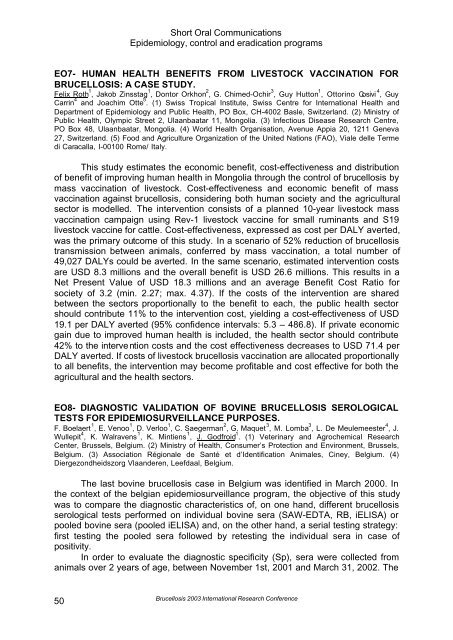Brucellosis 2003 proceedings - PHIDIAS
Brucellosis 2003 proceedings - PHIDIAS
Brucellosis 2003 proceedings - PHIDIAS
You also want an ePaper? Increase the reach of your titles
YUMPU automatically turns print PDFs into web optimized ePapers that Google loves.
Short Oral Communications<br />
Epidemiology, control and eradication programs<br />
EO7- HUMAN HEALTH BENEFITS FROM LIVESTOCK VACCINATION FOR<br />
BRUCELLOSIS: A CASE STUDY.<br />
Felix Roth 1 , Jakob Zinsstag 1 , Dontor Orkhon 2 , G. Chimed-Ochir 3 , Guy Hutton 1 , Ottorino Cosivi 4 , Guy<br />
Carrin 4 and Joachim Otte 5 . (1) Swiss Tropical Institute, Swiss Centre for International Health and<br />
Department of Epidemiology and Public Health, PO Box, CH-4002 Basle, Switzerland. (2) Ministry of<br />
Public Health, Olympic Street 2, Ulaanbaatar 11, Mongolia. (3) Infectious Disease Research Centre,<br />
PO Box 48, Ulaanbaatar, Mongolia. (4) World Health Organisation, Avenue Appia 20, 1211 Geneva<br />
27, Switzerland. (5) Food and Agriculture Organization of the United Nations (FAO), Viale delle Terme<br />
di Caracalla, I-00100 Rome/ Italy.<br />
This study estimates the economic benefit, cost-effectiveness and distribution<br />
of benefit of improving human health in Mongolia through the control of brucellosis by<br />
mass vaccination of livestock. Cost-effectiveness and economic benefit of mass<br />
vaccination against brucellosis, considering both human society and the agricultural<br />
sector is modelled. The intervention consists of a planned 10-year livestock mass<br />
vaccination campaign using Rev-1 livestock vaccine for small ruminants and S19<br />
livestock vaccine for cattle. Cost-effectiveness, expressed as cost per DALY averted,<br />
was the primary outcome of this study. In a scenario of 52% reduction of brucellosis<br />
transmission between animals, conferred by mass vaccination, a total number of<br />
49,027 DALYs could be averted. In the same scenario, estimated intervention costs<br />
are USD 8.3 millions and the overall benefit is USD 26.6 millions. This results in a<br />
Net Present Value of USD 18.3 millions and an average Benefit Cost Ratio for<br />
society of 3.2 (min. 2.27; max. 4.37). If the costs of the intervention are shared<br />
between the sectors proportionally to the benefit to each, the public health sector<br />
should contribute 11% to the intervention cost, yielding a cost-effectiveness of USD<br />
19.1 per DALY averted (95% confidence intervals: 5.3 – 486.8). If private economic<br />
gain due to improved human health is included, the health sector should contribute<br />
42% to the intervention costs and the cost effectiveness decreases to USD 71.4 per<br />
DALY averted. If costs of livestock brucellosis vaccination are allocated proportionally<br />
to all benefits, the intervention may become profitable and cost effective for both the<br />
agricultural and the health sectors.<br />
EO8- DIAGNOSTIC VALIDATION OF BOVINE BRUCELLOSIS SEROLOGICAL<br />
TESTS FOR EPIDEMIOSURVEILLANCE PURPOSES.<br />
F. Boelaert 1 , E. Venoo 1 , D. Verloo 1 , C. Saegerman 2 , G. Maquet 3 , M. Lomba 3 , L. De Meulemeester 4 , J.<br />
Wullepit 4 , K. Walravens 1 , K. Mintiens 1 , J. Godfroid 1 . (1) Veterinary and Agrochemical Research<br />
Center, Brussels, Belgium. (2) Ministry of Health, Consumer’s Protection and Environment, Brussels,<br />
Belgium. (3) Association Régionale de Santé et d’Identification Animales, Ciney, Belgium. (4)<br />
Diergezondheidszorg Vlaanderen, Leefdaal, Belgium.<br />
The last bovine brucellosis case in Belgium was identified in March 2000. In<br />
the context of the belgian epidemiosurveillance program, the objective of this study<br />
was to compare the diagnostic characteristics of, on one hand, different brucellosis<br />
serological tests performed on individual bovine sera (SAW-EDTA, RB, iELISA) or<br />
pooled bovine sera (pooled iELISA) and, on the other hand, a serial testing strategy:<br />
first testing the pooled sera followed by retesting the individual sera in case of<br />
positivity.<br />
In order to evaluate the diagnostic specificity (Sp), sera were collected from<br />
animals over 2 years of age, between November 1st, 2001 and March 31, 2002. The<br />
50<br />
<strong>Brucellosis</strong> <strong>2003</strong> International Research Conference
















